![]()
![]()
![]()
Use LEFT and RIGHT arrow keys to navigate between flashcards;
Use UP and DOWN arrow keys to flip the card;
H to show hint;
A reads text to speech;
55 Cards in this Set
- Front
- Back
|
Importance and Relevance of soils (7) |
soils cover virtually all of the Earth’s surface to understand biogeography all terrestrial food depends on soil the sustainable use of soils is essential ifproblems of exhaustion, erosion andpollution are to be avoided (adding fertiliser) inappropriate use of soils not only damagesthe soil but can lead to problems ofdrainage, flooding and mass movements geomorphology: erosion rates, riversediment, deposition soils take thousands of years to develop |
|
|
what is soil? why hard to define? |
“It is embarrassing not to be able toagree on what soil is. In thispedologists are not alone. Biologistscannot agree on a definition of life and philosophers on philosophy.” (Hans Jenny, The Soil Resource) |
|
|
why is soil? 3 definitions |
“... the unconsolidated mineral or organic materialat the surface of the Earth capable of supportinglife” “... a natural of body of animal, mineral andorganic constituents differentiated into horizonsof variable depth which differ from the materialbelowin morphology,physicalmakeup,chemicalproperties and composition and biologicalcharacteristics” “... the collection of natural bodies, formed on theEarth’s surface containing living matter andsupporting or capable of supporting plants” |
|
|
what is regolith? where may it have been formed? what part of the regolith is soil? what does it contain? what is it affected by? |
• unconsolidated material foundoverlying bedrock. material not forming solid rock • may have formed in situ or beentransported by water, wind or ice • soil is part of the regolith, and is usuallythe top part which contains a highconcentration of organic material and isaffected by weathering |
|
|
4 aspects that affect regolith |
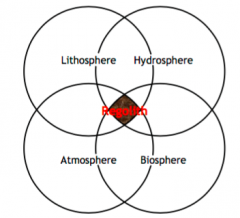
lithosphere hydrosphere atmosphere biosphere |
|
|
where are least evolved soils? |
scree slopes some plant growth (only?) |
|
|
The soil profile * |
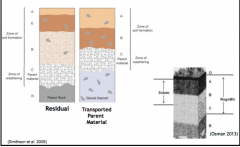
|
|
|
what is the soil profile? |
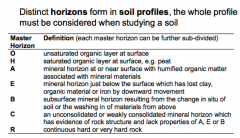
|
|
|
master horizon O |
unsaturated organic layer at surface |
|
|
master horizon H |
saturated organic layer at surface, e.g. peat |
|
|
master horizon A |
mineral horizon at or near surface with humified organic matterassociated with mineral materials |
|
|
master horizon E |
mineral horizon just below the surface which has lost clay,organic material or iron by downward movement |
|
|
master horizon B |
subsurface mineral horizon resulting from the change in situ ofsoil or the washing in of materials from above |
|
|
master horizon C |
an unconsolidated or weakly consolidated mineral horizon whichhas evidence of rock structure and lack properties of A, E or B |
|
|
master horizon R |
continuous hard or very hard rock |
|
|
what factors are soil formation controlled by? 5 pedological processes |
• climate • biological activity (organisms)• relief• parent material (e.g. rock)• time |
|
|
S = f (Cl, o, r, p, t ) what do these stand for? |

|
|
|
Influence of parent material 2 categories each into further two categories IMPORTANT |
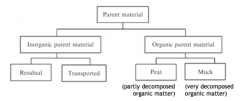
|
|
|
what are pedological processes? |
Pedology is the study of soils in their natural environment |
|
|
what is residual soil? |
formed in situ transported = not formed in situ |
|
|
what is solum? what is regolith? |
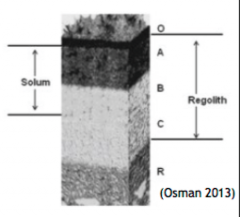
top part whole part |
|
|
which gets composed a lott - peat or muck? |
muck = very composed peat = partly composed |
|
|
what is loess? |
material formed and transported by the wind. fine material trapped by plants and can form soil. e.g.. in china gobi desert |
|
|
what is gley? |
waterlogged mineral soils don't make very good soils |
|
|
what are andosols? |
icelandic ash fertile parent material |
|
|
why britain ahead in soil research? |
area of one of most varied soils in world in a little area |
|
|
NEED TO LEARN THIS DIAGRAM Influence of parent material |
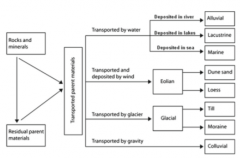
|
|
|
different parent material = different soils british isles 4 examples volcanic material 1 example |

|
|
|
british isles basic rock example |
Cambisols (rich brown earths) |
|
|
british isles acid rocks |
Podzols (poor acid soils) |
|
|
british isles limestones |
Cambisols (rich brown earths) |
|
|
british isles glacial till example |
Gley soils (waterlogged clay-rich soil) |
|
|
5 6? ways climate has influence on soils |
rainfall temperature weathering (temperature and rainfall) vegetation types length of growing season pedoclimate? |
|
|
what is pedoclimate? |
a microclimate within soil that integrates the combined effects of its temperature, water content and aeration soil climate at ground level can get pedocllimate forecasts / measurements from MET Office |
|
|
influence of climate on soil rainfall how? |
High and low rainfall impact on types of weathering Lower rainfall – salt crusts/lime layers Higher rainfall – leaching of soluble salts, more clays, organic matter, cation exchange capacity and nutrientsincrease |
|
|
influence of climate on soil temperature how? |
heavy rain and high temperatures lead to rapidbreakdown of organic material small increase in clay minerals with temperature Evaporation (impact depends on rainfall) |
|
|
influence of climate on soil all |

|
|
|
influence of biological activity 3 types |
plants microorganisms micro-organisms |
|
|
influence of biological activity on soil MICROORGANISMS give 4 examples |
• Micro-organisms (e.g. bacteria, fungi,algae, protozoa) {break down organic matter to simpler components that can be used by other organisms] • anaerobic and aerobic bacteria • nitrifying bacteria • denitrifying bacteria • fungi - break down organic material |
|
|
what are macro-organisms? |
anthropods (insects e.g.. dung beetle) small animals (e.g..moles) they are good for mixing up the soil |
|
|
influence of biological activity MACRO-ORGANISMS? |
• earthworms mix organic and mineralmatter arthropods also mix soil (insects e.g.. dung beetle) slugs and snails breakdown organicmaterial small animals loosen and mix soils (e.g..moles) |
|
|
influence of biological activity PLANTS? |
Litter and roots supply soil with nutrients andorganic matter Different types of tree produce different soils,e.g. coniferous trees lead to podzolization seasonal vegetation Rhizosphere around roots important site for exchange of nutrients. Symbiotic relationshipswith fungi and bacteria, e.g. nitrogen fixing |
|
|
What is podolization? |
a process of soil formation especially in humid regions involving principally leaching of the upper layers with accumulation of material in lower layers and development of characteristic horizons; specifically : the development of a podzol. increases acidity of soil. changes type of soil. |
|
|
Influence of relief 4 factors |
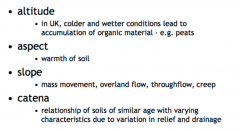
|
|
|
Influence of relief altitude |
• in UK, colder and wetter conditions lead toaccumulation of organic material - e.g. peats affects rainfall |
|
|
Influence of relief aspect |
• warmth of soil direction of soil. effects warmth. want south facing slope in northern hemisphere for vines |
|
|
Influence of relief slope |
• mass movement, overland flow, throughflow, creep |
|
|
Influence of relief catena |
• relationship of soils of similar age with varyingcharacteristics due to variation in relief and drainage |
|
|
what is catena? |
A soil catena is a sequence of different soil profiles that occur down a slope. They occur on hill slopes where the geology is uniform and there is no marked difference in climate from the top to the bottom of the slope. |
|
|
what is aspect? |
aspect is the compass direction that a slope faces. |
|
|
how long does it take a soil to form? |

|
|
|
in fluency of time what are young soils like? |
• tend to share features with parent material • pedological begin to mask parent material with time |
|
|
in fluency of time what are older (mature soils) like? |
• mature soils are in equilibrium with theirenvironment • often very different from parent material • very old soils can be nutrient poor (e.g. Australia) |
|
|
how old are british soils? |
• British soils mostly less than 10,000years old quite young due to glaciation scraping slate and starting soil formation from the beginning |
|
|
what influences soil? (4 major categories) |
time relief biological activity climate |

